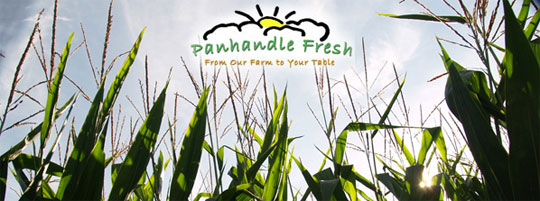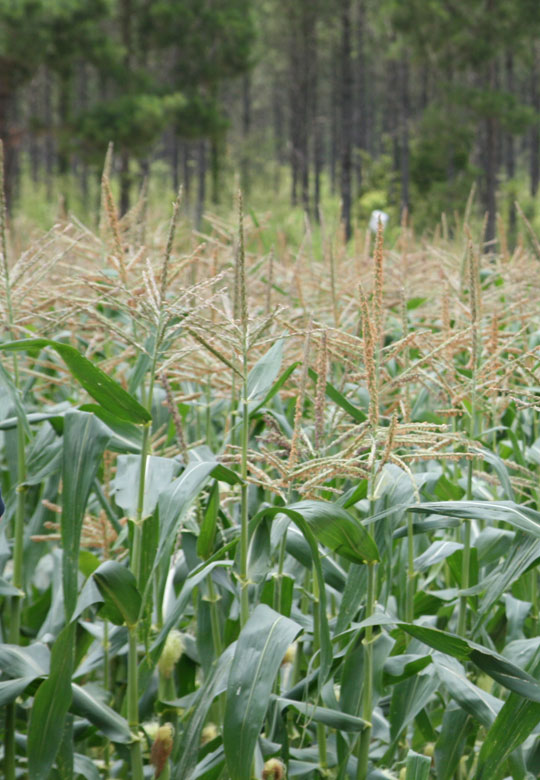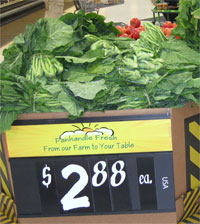Panhandle Fresh: Group Markets Local Produce
March 23, 2009

The watermelon and the sweet corn you buy at Wal-Mart late this spring or during the summer may just be from North Escambia. Or the peanuts, or the peppers, or one of the many crops that the marketing cooperative Panhandle Fresh helps local farmers market to the world’s largest retailer.
 “I never thought I would be selling my sweet corn in Wal-Mart,” Walnut Hill farmer Steve Hiebert told NorthEscambia.com.
“I never thought I would be selling my sweet corn in Wal-Mart,” Walnut Hill farmer Steve Hiebert told NorthEscambia.com.
Panhandle Fresh handles the marketing, the insurance and logistics of getting produce like Steve’s Sweet Corn from Walnut Hill to Wal-Mart. Panhandle Fresh secures the orders from Wal-Mart and works with local farmers to get coordinate the produce delivery.
“We really just work between the farmers and Wal-Mart to sell what is on the land,” said Andrea Sutrick, marketing coordinator from Panhandle Fresh. Sutrick recently joined Panhandle Fresh after working for Kraft Foods for 10 years to secure shelf space for Kraft products.
“This year we hope to ramp it up a little bit and experiment with more production,” Sutrick said.
No matter the scale, Panhandle Fresh Executive Director Cindy Anderson said selling to a giant retailer is very different for most farmers than selling on their farms or at curbside markets.
“This isn’t for everbody,” Anderson said. “We encourage farmers to commit just 20 percent of their crops to the Panhandle Fresh program. This gives us and the producers a chance to figure out how to best make the program work. I’d rather walk before we run.”
 Panhandle Fresh sits between the farmer and Wal-Mart, providing the $3 million in liability insurance that Wal-Mart requires. The group also provides the marketing, works to secure shelf space for the products, takes care of most paperwork and bills Wal-Mart for the produce. The farmer delivers his goods, bills Panhandle Fresh and receives a check for the fresh goods.
Panhandle Fresh sits between the farmer and Wal-Mart, providing the $3 million in liability insurance that Wal-Mart requires. The group also provides the marketing, works to secure shelf space for the products, takes care of most paperwork and bills Wal-Mart for the produce. The farmer delivers his goods, bills Panhandle Fresh and receives a check for the fresh goods.
Most farmers are happy with the price that they receive, Anderson said, making it a win-win situation for everyone. Wal-Mart gets the freshest product possible from local farms, and the local farmers that participate get a much needed financial boost.
In addition to Steve’s Sweet Corn from Walnut Hill, Walnut Hill farmer Jerry Davis’ watermelons and Holland Farms peanuts from Jay are among the top Panhandle Fresh products sold in area Wal-Marts in the Florida Panhandle.
Coming up Tuesday, we’ll take a look at one of the big challenges faced by the farmers that participate in Panhandle Fresh, and how the solution may just mean more jobs in North Escambia.
Pictured top and top middle: Steve’s Sweet Corn from Walnut Hill is just one of the products that Panhandle Fresh works to get from area fields in into retail giant Wal-Mart. Pictured bottom middle: Panhandle Fresh greens being sold in an area Wal-Mart. Submitted and NorthEscambia.com file photos, click to enlarge.
Comments
One Response to “Panhandle Fresh: Group Markets Local Produce”



For farming this appears to be the future; a mixture of locally sourced meats and produce and some shipped in product from the corporate ag industry. It provides better product, gathered closer to maturity while giving the customer the freshness they desire. The current farming model developed in the seventies when Nixon’s Ag Secretary said to “get big or get out” has the unfortunate effect of nearly killing the small farms that supported communities in a much more direct manner. Charlotte has small and large farmer’s markets all around city and surrounding towns and it is getting larger and larger. As we learn of the problems of large feed lots for cattle and hogs, the problems with produce geared toward long shelf life instead of nutrition, and the improvement in all the meats and produce when farmed in what is now called organic, but in reality was traditional farming until we pushed them out for our current agri-business model that is focused only on quantity. So now we have eggs higher in bad cholesterol, cattle and hogs given too many antibiotics to stave off infections mainly from being crowded into feed lots, and the list goes on.
Anyone interested in reading about some of the issues involved in this farming debate should read “Omnivore’s Dilemma” by Michael Pollen.